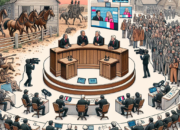The Future of the Conservative Party: Challenges Ahead
In 2025, the landscape of political parties across the globe is undergoing unprecedented transformations. One party that stands at a significant crossroads is the Conservative Party. As political ideologies evolve and voter expectations change, the Conservative Party faces numerous challenges that could shape its future trajectory. This article delves into the primary obstacles the party confronts, analyzes its strategic options moving forward, and discusses how it can innovate while remaining true to its foundational principles. Understanding the current climate and potential shifts is crucial for the Conservative Party as it aims to retain relevance and support in a rapidly changing world.
Resurgence of Populism: A Key Challenge for Traditional Conservatives
The rise of populism across the globe stands as one of the most pressing challenges for the Conservative Party in 2025. This trend has reshaped the political conversation, encouraging parties to adopt more radical platforms to appeal to disenchanted voters. Populism thrives on discontent with established political norms, portraying traditional politicians as disconnected from the struggles of ordinary citizens. For the Conservative Party, countering this movement requires a nuanced understanding of voter sentiment and a strategic recalibration of its message.
To navigate the populist wave, the Conservative Party might need to reassess its approach to economic and social issues. Engaging with voters who feel alienated by globalization and technological change is essential. This involves presenting policies that directly address economic insecurity, job displacement, and rising inequality—areas where populist figures have surged by offering simplistic solutions. By integrating grassroots perspectives into policy development and emphasizing economic sustainability, the Conservative Party can reclaim its influence while warding off potential fragmentation.
Demographic Shifts and Their Impact on Party Dynamics
As we progress through 2025, the demographic profile of voters continues to shift dramatically. Young voters, increasingly diverse and progressive in their outlook, are vital to electoral success yet often feel alienated from the more traditional values marketed by the Conservative Party. For the party to thrive, it must engage meaningfully with younger generations and address the issues that resonate with them, such as climate change, social justice, and economic equity.
Moreover, the party faces a challenge in its historical voter base, which is gradually aging and declining in numbers. To remain electorally viable, the Conservative Party must broaden its appeal beyond its traditional demographic segments. This necessitates a proactive approach to policy-making and outreach that recognizes the unique needs of emerging voter subsets. For instance, supporting initiatives that promote educational access and vocational training can resonate with both young voters and those affected by labor market changes. By adapting its messaging and policy priorities, the Conservative Party can position itself more favorably in an increasingly competitive electoral landscape.
Internal Cohesion and the Fragmentation of Ideological Beliefs
Another significant challenge facing the Conservative Party is internal cohesion amid a burgeoning ideological divide. With the rise of various factions within the party—ranging from traditional conservatives to more libertarian and populist factions—managing these diverging views has become increasingly complex. If these factions are unable to reconcile their differences, the party could risk splintering into irrelevance.
Leadership plays a critical role in navigating this fragmentation. Strong, unifying figures who can bridge ideological divides and inspire confidence across the party will be essential in maintaining cohesion. Creating a robust internal dialogue that encourages diverse perspectives while promoting unity is crucial for strategic decision-making. The party leadership must articulate a clear vision that acknowledges the varying beliefs within the party while reinforcing common goals that appeal to a broader electorate.
Additionally, investing in grassroots engagement can support cohesion. By connecting with local party members and constituents, the Conservative Party can foster a sense of belonging and shared purpose. Encouraging active participation in policy discussions and candidate selection helps amplify the voices of committed party members, making them feel valued and more aligned with the party’s overarching mission.
Global Economic Uncertainties: Adapting Policy for Future Resilience
In 2025, global economic uncertainties pose a considerable challenge for the Conservative Party. As markets oscillate due to geopolitical tensions, climate change repercussions, and pandemics, crafting sound economic policies that inspire confidence among constituents is pivotal. The party needs to address immediate economic concerns while also preparing for long-term stability and growth strategies.
Rethinking economic policy could involve embracing a hybrid model that promotes both market-driven innovation and state intervention. Historical Conservative ideals often favor less government involvement; however, the current economic climate necessitates pragmatic solutions. This might include advocating for infrastructure investments that create jobs while also investing in green technologies aimed at combating climate change. By aligning economic recovery with sustainable practices, the party could appeal not only to traditional voters but also to a new generation of environmentally conscious citizens.
Moreover, an emphasis on fair trade practices and strong international partnerships can help reassure voters that the party is committed to a globalized economy that benefits everyone. The Conservative Party can leverage policies that promote economic collaboration and investment in emerging markets to bolster its status as a viable alternative in a fluctuating global economy. By framing economic policies as proactive rather than reactive, the party can cultivate a vision of forward-thinking leadership that resonates with voters.
Leveraging Technology and Social Media for Political Engagement
In the modern political arena, technology and social media have transformed how parties communicate and engage with their constituents. The Conservative Party must harness these tools effectively to connect with voters, particularly younger demographics who gravitate towards platforms such as TikTok, Instagram, and Twitter. A strategic digital presence can build brand loyalty and inform constituents about policy initiatives, party events, and community engagements.
Creating engaging, shareable content is key to establishing a recognizable online identity. Short videos, infographics, and interactive webinars can reach and engage a wider audience, enabling the party to explain complex policies in an easily digestible format. Moreover, leveraging data analytics can help the party understand voter preferences and feedback in real-time, allowing for more responsive strategist modifications as needed.
However, as the Conservative Party embraces digital platforms, it must also navigate the complexities of misinformation and polarization that often accompany online discourse. Establishing clear guidelines for responsible communication and promoting a positive narrative around the party’s initiatives can help counteract negative perceptions. This approach not only aids in maintaining credibility but also strengthens a community of informed supporters dedicated to advancing the party’s goals.
Conclusion
As the Conservative Party looks towards the future, the hurdles ahead will require strategic adaptability, unifying leadership, and a progressive approach to policy-making. Addressing the rise of populism, engaging younger voters, fostering internal cohesion, navigating economic uncertainties, and leveraging technology will be crucial for the party’s survival and growth. By proactively responding to these challenges, the Conservative Party can position itself as a relevant and dynamic force in contemporary politics, ensuring its voices resonate with a diverse electorate in the years to come.
FAQs
What are the main challenges facing the Conservative Party in 2025?
The Conservative Party confronts several key challenges, including the rise of populism, demographic shifts affecting its traditional voter base, internal cohesion amid ideological fragmentation, and the need to adapt economic policies in response to global uncertainties.
How can the Conservative Party attract younger voters?
To attract younger voters, the Conservative Party must engage with their priorities, such as climate change and social justice, by promoting policies that resonate with these issues. Leveraging social media and digital platforms to connect with younger demographics is also essential.
What role does technology play in modern political campaigning for the Conservative Party?
Technology plays a crucial role in political campaigning by enabling the Conservative Party to connect with voters through social media, create engaging content, and analyze data to inform strategy. Utilizing technology effectively can help broaden the party’s appeal and enhance voter engagement.








